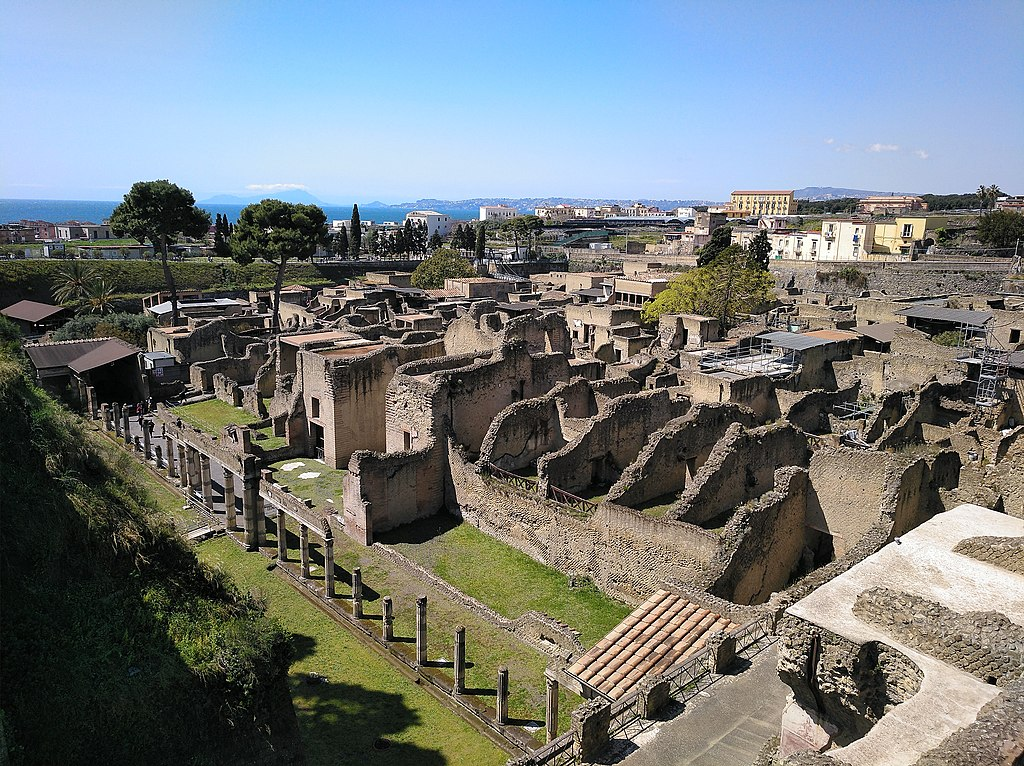
Herculaneum (Neapolitan and Italian: Ercolano) was an ancient Roman town, located in the modern-day comune of Ercolano, Campania, Italy. Herculaneum was buried under volcanic ash and pumice in the Eruption of Mount Vesuvius in 79 AD.
Like the nearby city of Pompeii, Herculaneum is famous as one of the few ancient cities to be preserved nearly intact, as the ash that blanketed the town protected it against looting and the elements. Although less known than Pompeii today, it was the first and, for a long time, the only discovered Vesuvian city (in 1709). Pompeii was revealed in 1748 and identified in 1763. Unlike Pompeii, the mainly pyroclastic material that covered Herculaneum carbonized and preserved more wooden objects such as roofs, beds, and doors, as well as other organic-based materials such as food and papyrus.
- Ozgenel, Lalo (15 April 2008). “A Tale of Two Cities: In Search of Ancient Pompeii and Herculaneum”. Journal of the Faculty of Archaeology. 2008, Ankara: Middle East Technical University. 25 (1): 1–25. http://jfa.arch.metu.edu.tr/archive/0258-5316/2008/cilt25/sayi_1/1-25.pdf
According to the traditional tale, the city was rediscovered by chance in 1709, during the drilling of a well. Remnants of the city, however, were already found during earlier earthworks. In the years following the site’s uncovering, treasure seekers excavated tunnels and took artifacts. Regular excavations commenced in 1738 and have continued irregularly since. Today, only a fraction of the ancient site has been excavated. The focus has shifted to preserving the already-excavated portions of the city rather than exposing more.
- Wallace-Hadrill, Andrew (2011). Herculaneum: Past and Future. ISBN 978-0-7112-3142-9. p47
Although smaller than Pompeii with a population of circa 5,000, Herculaneum was a wealthier town. It was a seaside retreat for the Roman elite, as reflected by the extraordinary density of luxurious houses featuring lavish use of coloured marble cladding. Buildings of the ancient city include the Villa of the Papyri and the so-called “boat houses”, where the skeletal remains of at least 300 people were found.
- De Ligt et al. (2012). “The Album of Herculaneum and a model of the town’s demography.” Journal of Roman Archaeology, 25, 69–94. doi:10.1017/S1047759400001148
- Wallace-Hadrill, Andrew (2011). Herculaneum: Past and Future. ISBN 978-0-7112-3142-9. p55
History of Herculaneum
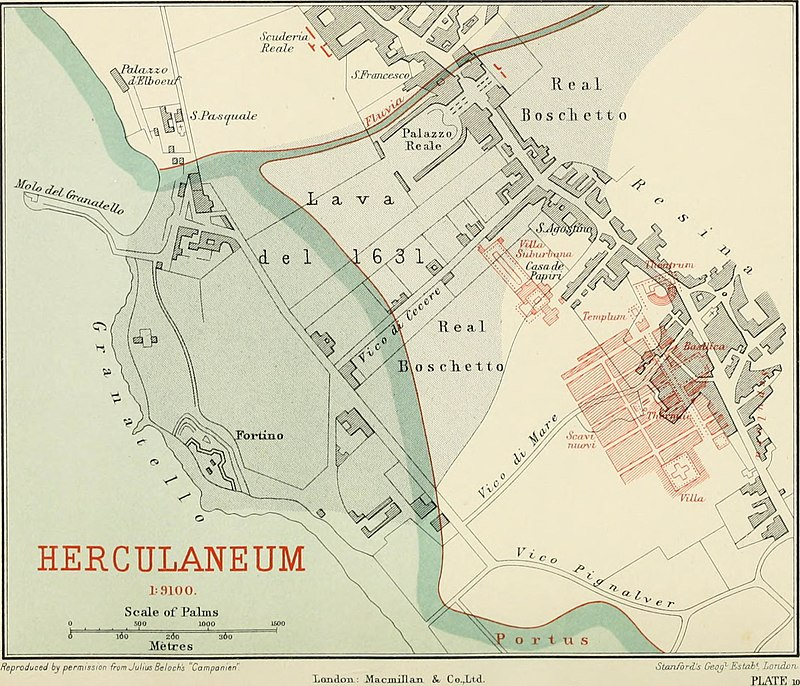
Dionysius of Halicarnassus states that the Greek hero Heracles (Hercules in Latin) founded the city. However, according to Strabo, the Oscans founded the first settlement. The Etruscans took control of the area, and were later overthrown by the Greeks. The Greeks named the town Heraklion and used it as a trading post because of its proximity to the Gulf of Naples. In the 4th century BC, Herculaneum came under the domination of the Samnites.
- Antiquitates Romanae 1.44
- Strabo, Geography V, 4, 8
In the 2nd century BC the city walls were built (between 2 and 3 metres thick), constructed primarily of large pebbles, with the exception of the coastal section made of opus reticulatum. It participated in the Social War (91–88 BC) on the side of the “Allies” against Rome and was defeated by Titus Didius, a legate of Sulla. Following the war the walls lost their protective purpose and were integrated into houses and adjacent structures, such as the House of the Inn.
It became a Roman municipium in 89 BC.[citation needed]
The eruption of Mount Vesuvius in AD 79 buried Herculaneum under approximately 20 m (66 ft) of ash. It lay hidden and largely intact until discoveries from wells and tunnels became gradually more widely known, notably following the Prince d’Elbeuf’s explorations in the early 18th century. Excavations continued sporadically up to the present and today many streets and buildings are visible, although over 75% of the town remains buried. Today, the Italian towns of Ercolano and Portici lie above Herculaneum. Ercolano was called Resina until 1969 when the modern name was adopted in honour of the old city.
- Wallace-Hadrill, Andrew (2011). Herculaneum: Past and Future. ISBN 978-0-7112-3142-9.
Eruption of 79 AD
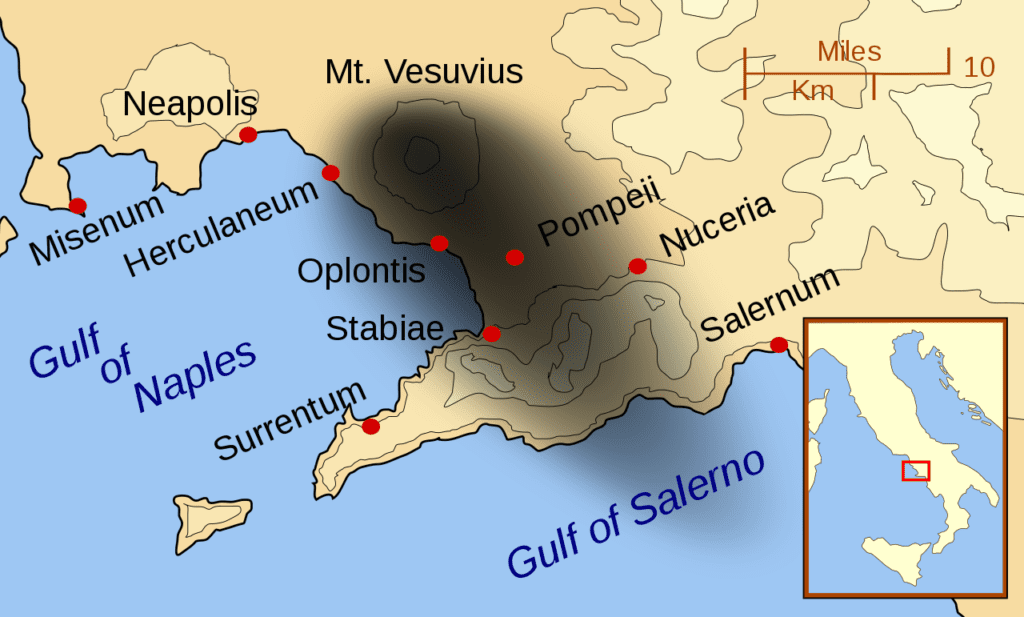
Main article: Eruption of Mount Vesuvius in 79 AD
The course and timeline of the eruption can be reconstructed based on archaeological excavations and two letters from Pliny the Younger to the Roman historian Tacitus.
- Available at the University of Arizona: Pliny the Younger, Letters 6.16 and 6.20 to Cornelius Tacitus and in Project Gutenberg: Letter LXV — To Tacitus, Letter LXVI — To Cornelius Tacitus
At around 1 pm on the first day of eruption, Mount Vesuvius began spewing volcanic material thousands of metres into the sky. When it reached a height of 27–33 km (17–21 mi), the top of the column flattened, prompting Pliny to describe it to Tacitus as a stone pine tree. The prevailing winds at the time blew toward the southeast, causing the volcanic material to fall primarily on the city of Pompeii and the surrounding area. Since Herculaneum lay west of Vesuvius, it was only mildly affected by the first phase of the eruption. While roofs in Pompeii collapsed under the weight of falling debris, only a few centimetres of ash fell on Herculaneum, causing little damage; nevertheless, the ash prompted most inhabitants to flee.
- Sigurdsson, Haraldur (2001), “Volcanology”, in Meyers, Robert A. (ed.), Encyclopedia of Physical Science and Technology (Third Edition), Elsevier, pp. 579–605
At 1 am the next day, the eruptive column, which had risen into the stratosphere, collapsed onto Vesuvius and its flanks. The first pyroclastic surge, formed by a mixture of ash and hot gases, flowed down the mountain and through the mostly-evacuated town of Herculaneum at 160 km/h (100 mph). A succession of six flows and surges buried the city’s buildings to approximately 20 m depth, causing little damage in some areas and preserving structures, objects and victims almost intact. However, other areas were damaged significantly, knocking down walls, tearing away columns and other large objects; a marble statue of Marcus Nonius Balbus near the baths was blown 15m away and a carbonised skeleton was found lifted 2.5m above ground level in the garden of the House of the Relief of Telephus.
- The Herculaneum Society. Archived 22 February 2012 at the Wayback Machine. p. 3.
- Hooper, John (23 July 2012). “House of the Telephus Relief: raising the roof on Roman real estate”. The Guardian. ISSN 0261-3077. Retrieved 20 March 2023.
- “House of the Relief of Telephus – AD79eruption”. sites.google.com
The date of the eruption has been shown to be on or after 17 October. Support for an October/November eruption has long been known in several respects: buried people in the ash were wearing heavier clothing than the light summer clothes typical of August; fresh fruit and vegetables in the shops are typical of October – and conversely the summer fruit typical of August was already being sold in dried, or conserved form. Wine fermenting jars had been sealed, which would have happened around the end of October; coins found in the purse of a woman buried in the ash include one with a 15th imperatorial acclamation among the emperor’s titles and could not have been minted before the second week of September.
- “Pompeii’s destruction date could be wrong”. BBC News. 16 October 2018.
- Stefani, Grete (October 2006). La vera data dell’eruzione. Archeo
Multidisciplinary research on the lethal effects of the pyroclastic surges in the Vesuvius area has shown that, in the vicinity of Pompeii and Herculaneum, intense heat was the main cause of the death of people who had previously been thought to have died by ash suffocation. Exposure to ≥250 °C (480 °F) had likely killed residents within 10 km, including those sheltering in buildings.
- Mastrolorenzo, G; Petrone, P; Pappalardo, L; Guarino, FM (15 June 2010). “Lethal thermal impact at periphery of pyroclastic surges: evidences at Pompeii”. PLOS ONE. 5 (6): e11127. Bibcode:2010PLoSO…511127M. doi:10.1371/journal.pone.0011127. PMC 2886100. PMID 20559555.
Archaeology

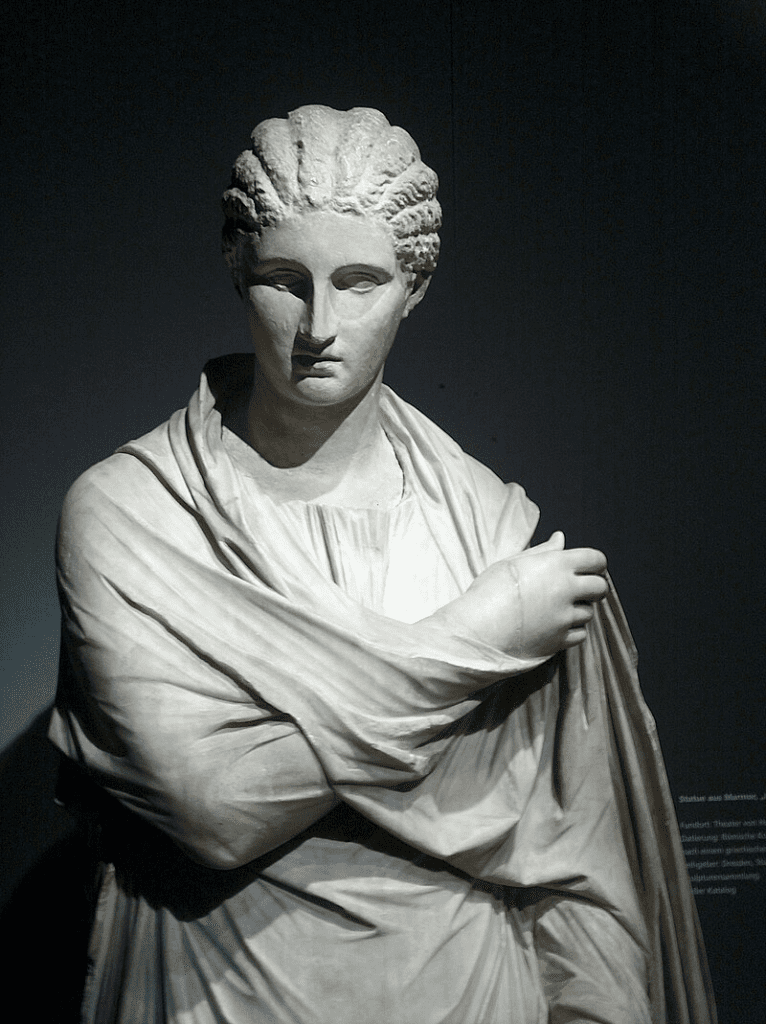
Prince d’Elbeuf began constructing a villa in neighbouring Granatello, and to furnish it, he grew intrigued in local tales of wells containing antique sculptures and artworks. In 1709, he acquired the site of a recently-dug well and tunnelled out from its bottom in search of sculptures. The tunnel reached what would be later identified as a theatre, where remarkable sculptures were uncovered. Among the earliest sculptures discovered were two exquisitely carved Herculaneum women, currently housed in the Skulpturensammlung in Dresden. The excavation ceased in 1711 out of concern about the stability of the structures above.
- Wallace-Hadrill, Andrew (2011). Herculaneum: Past and Future. ISBN 978-0-7112-3142-9. p 47
- THE LARGE AND THE SMALL HERCULANEUM WOMAN, Universita Ca’ Foscari, Venezia, Doctoral Thesis 2014–2015, Angeliki Ntontou
- The Herculaneum Women: And the Origins of Archaeology (J. Paul Getty Museum) – 7 Feb 2008, Daehner
Major excavations resumed in 1738 under the patronage of Charles III of Spain, who had recently begun building his nearby palace in Portici. He appointed the Spanish military engineer Roque Joaquin de Alcubierre to supervise the extensive new project. The publication of “Le Antichità di Ercolano” (“The Antiquities of Herculaneum”) had a striking influence on nascent European Neoclassicism; by the end of the 18th century, motifs from Herculaneum began to appear on fashionable furnishings, including decorative wall-paintings, tripod tables, perfume burners, and teacups. Nonetheless, excavation ceased once again in 1762 as a result of Winckelmann‘s harsh criticism of the treasure-hunting techniques. The discovery of neighbouring Pompeii, substantially simpler to excavate due to a smaller layer of material covering the site (4m as compared to 20m at Herculaneum), diverted attention and effort.
King Francis I ordered land acquisitions and promoted renewed excavations between 1828 and 1837. Acquisitions continued under the newly formed Kingdom of Italy, extending excavations eastwards till 1875.
- Wallace-Hadrill, Andrew (2011). Herculaneum: Past and Future. ISBN 978-0-7112-3142-9. p62
From 1927 until 1942, Amedeo Maiuri conducted a new campaign, sponsored by Mussolini‘s regime, which unearthed approximately four hectares which today are part of the archaeological park.
Hundreds of skeletons were found in the so-called “boat houses”, by the ancient shoreline, between 1980 and 1981.
The Villa of the Papyri, the northwest baths, the House of the Dionysian Reliefs and a large collapsed monument were brought to light between 1996 and 1999. However, the area was left in a chaotic state until major conservation interventions from 2000 through 2007.
- “Northwest Baths – AD79eruption”. sites.google.com.
- “House of the Dionysian Reliefs – AD79eruption”. sites.google.com.
Many public and private buildings, including the forum complex, are yet to be excavated.
| showThis article may be expanded with text translated from the corresponding article in Italian. (June 2015) |
Site
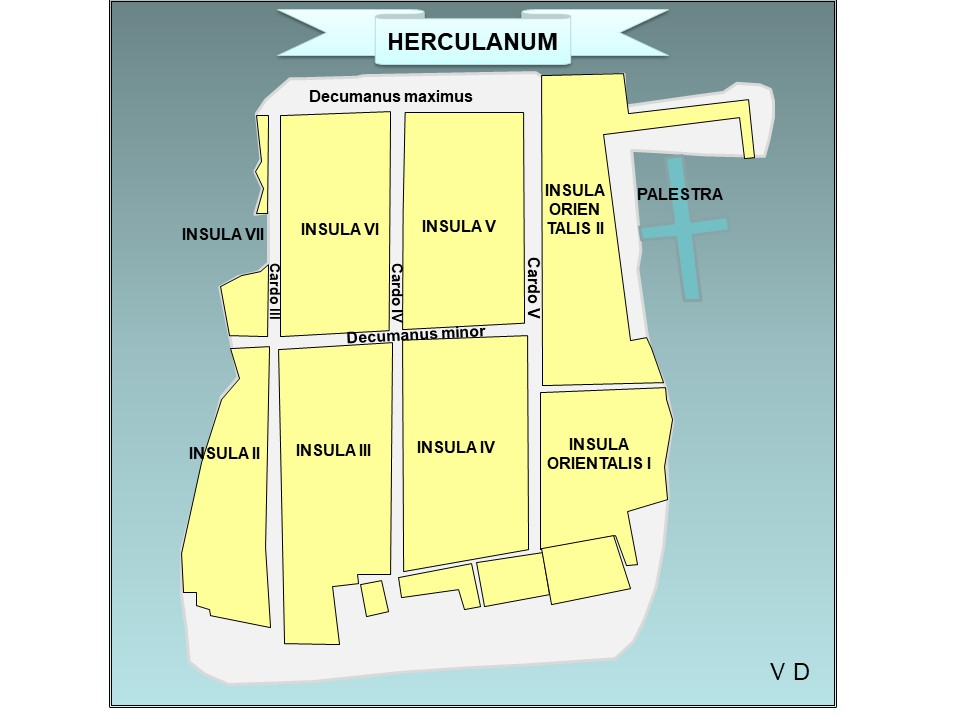
The classical street layout separates the city into blocks (insulae), defined by the intersection of the east–west (cardi) and north–south (decumani) streets. Hence Insula II to Insula VII run counterclockwise from Insula II. To the east are two additional blocks: Orientalis I (oI) and Orientalis II (oII). To the south of Orientalis I (oI) lies one additional group of buildings known as the “Suburban District” (SD). Individual buildings have their own entrance number. For example, the House of the Deer is labelled (Ins IV, 3).
The Forum, temples, theatre, numerous houses and necropoles are still buried.
Due to bradyseism, which affects the entire Vesuvius region, portions of the historic city of Herculaneum today lie as much as 4 metres below sea level.
- Cinque, A. and Irollo, G. (2008) “Lapaleogeografia dell’antica Herculaneum e lefluttuazioni, di origine bradisismica, dellasua linea di costa”. In P. G. Guzzo andM. P. Guidobaldi, eds., Nuove ricerche archeologiche nell’area Vesuviana (scavi 2003–2006): 425–38
A single main drain collected water from the Forum and from house impluviums, latrines and kitchens along Cardo III.[citation needed] Other drains emptied directly into the street, except latrines equipped with a cesspit. For water supply, the city was directly connected to the Serino aqueduct, built in the Augustan age, which brought water to buildings through a series of lead pipes under the roads, regulated by valves; wells had been used previously.
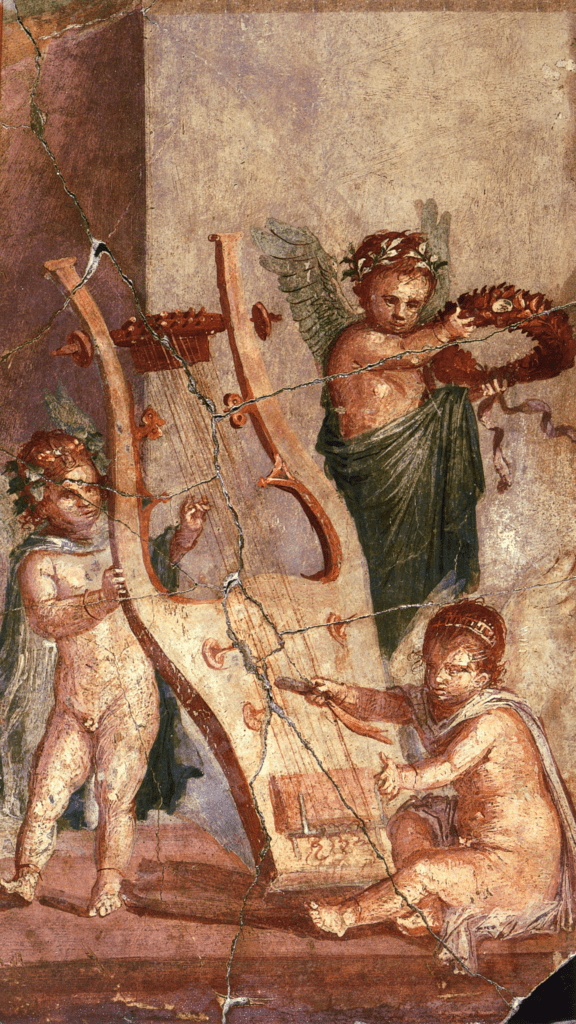
The House of Aristides (Ins II, 1)
The first building in insula II is the House of Aristides. The entrance opens directly onto the atrium, but the ruins are not well preserved due to damage caused by previous excavations. The lower floor was probably used for storage.
The House of Argus (Ins II, 2)
The second house in insula II takes its name from a lost fresco of Argus and Io that once adorned a reception room off the large peristyle. This structure was likely one of Herculaneum’s finest villas. It was the first time that a second story had been unearthed in such detail when the house was discovered in the late 1820s. The excavation uncovered a balcony on the second level overlooking Cardo III, as well as wooden shelving and cupboards now lost.
The House of the Genius (Ins II, 3)
North of the House of Argus lies the House of the Genius. Although it has only been partially uncovered, it appears to have been a vast structure. Its name derives from a statue of a Cupid, once part of a candlestick. In the centre of the peristyle are the remains of a rectangular basin.
The House of the Alcove (Ins IV)
The house consists of two adjoined structures with a mix of plain, simple spaces and finely-decorated rooms.
The atrium is covered and lacks the usual impluvium. It retains its original flooring of opus tesselatum and opus sectile. A highly adorned biclinium (a dining-couch for two persons) with frescoes in the fourth style and a spacious triclinium originally marble-floored are found off the atrium. Several further rooms, including the apsed alcove after which the house is named, are accessible via a corridor receiving daylight from a small courtyard.
- “Charlton T. Lewis, Charles Short, A Latin Dictionary, biclīnĭum”. www.perseus.tufts.edu. Retrieved 20 March 2023.
College of the Augustales
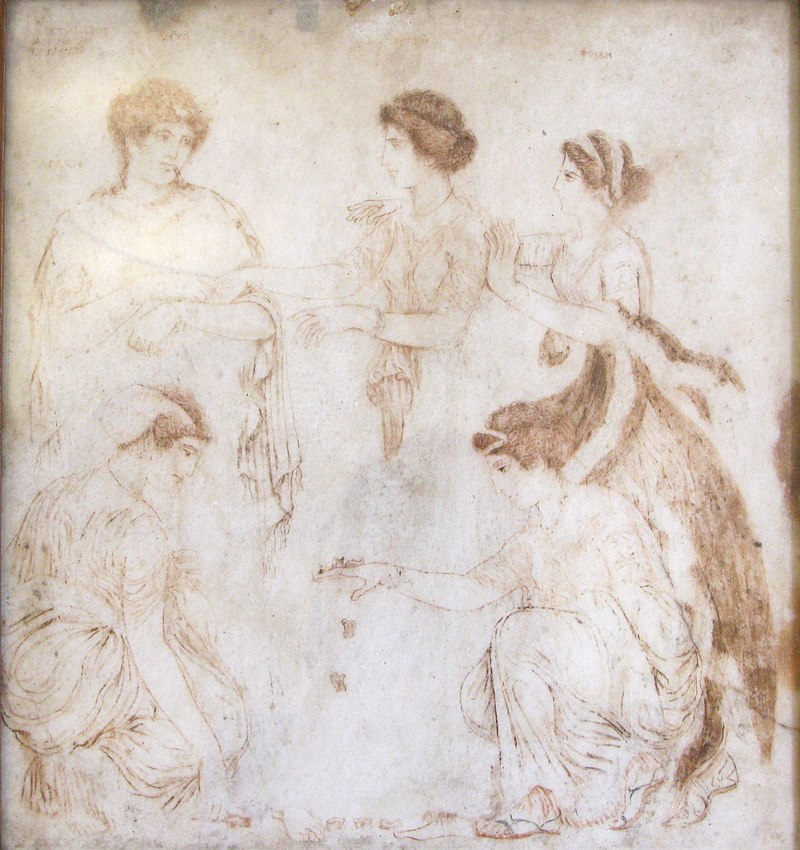
Temple of the Augustales or priests of the Imperial cult.
Central Thermae
The Central Thermae (bathhouses) were built around the 1st century AD. Bathhouses were popular at the time, especially in Pompeii and Herculaneum. Per common practice, there were separate bathing areas for men and women. The Thermae also served as a prominent cultural hub home to works of art.
Villa of the Papyri
Main article: Villa of the Papyri
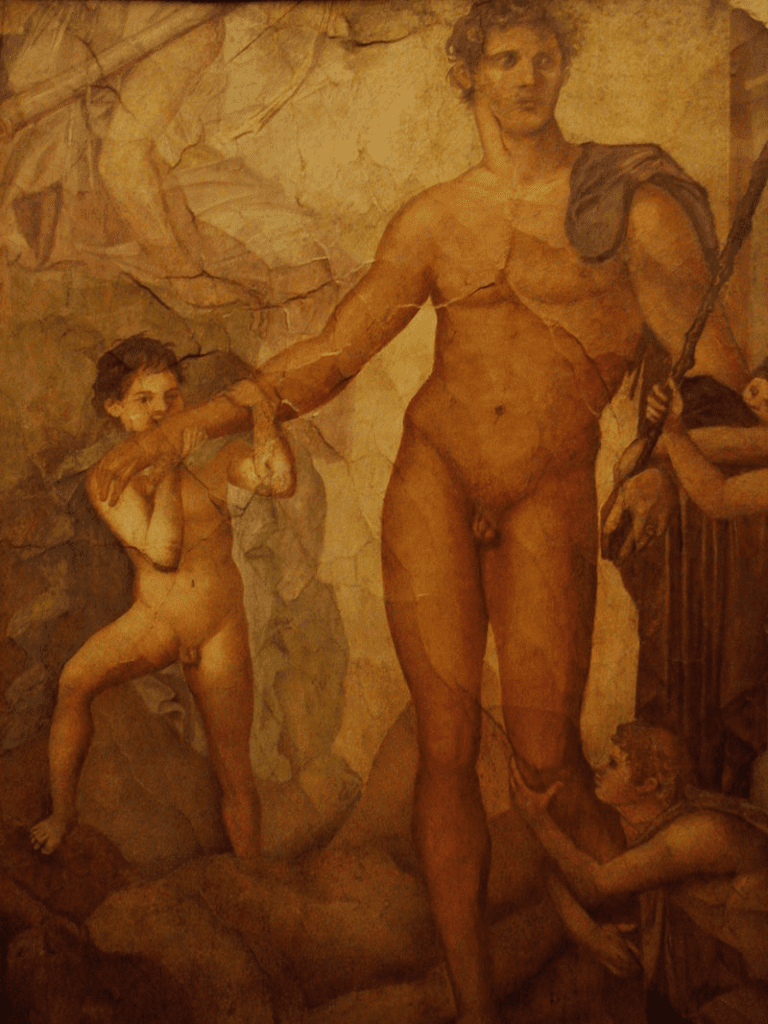
The most famous among Herculaneum’s luxurious villas, Villa of the Papyri, was built on the seashore on four terraces. It is thought to have belonged to consul Lucius Calpurnius Piso Caesoninus, Julius Caesar‘s father-in-law, who was a patron of poets and philosophers and built there the only ancient library that has survived virtually intact.
Between 1752 and 1754, a number of blackened, unreadable papyrus scrolls were recovered from the Villa of the Papyri by workmen. These scrolls became known as the Herculaneum papyri or scrolls, the majority of which are today stored at the National Library, Naples. Although badly carbonized, a number of scrolls have been unrolled with varying degrees of success. Computer-enhanced multi-spectral infrared imaging helped make the ink legible. There is now a real prospect that it will be possible to read the unopened rolls using X-rays. The same techniques could be applied to the rolls waiting to be discovered in the as-yet unexcavated part of the villa, eliminating the risk of potential damage from unrolling. Later CT scan revealed the scrolls’ fibres structure, sand, and other debris trapped in the scrolls. These findings help a safer unrolling. However, the text remains illegible.
- “Digital Exploration: Unwrapping the Secrets of Damaged Manuscripts”. www.research.uky.edu. Archived from the original on 1 February 2006. Retrieved 16 December 2016.
- Banerji, Robin (20 December 2013). “Unlocking the scrolls of Herculaneum”. BBC News. Retrieved 27 December 2018.
Two of the rolls stored at the French National Academy in Paris have been extensively examined by X-ray in summer 2009. However, the text imaging failed because Roman writers likely used carbon-based inks, essentially invisible to the X-ray scans. Similar later attempts all failed.
- “UK scientists stymied in effort to read ancient scrolls”. kentucky. Retrieved 16 December 2016.
In 2015, a team of scientists managed to increase the contrast between the carbon ink and the carbon-based papyrus using X-ray Phase Contrast Tomography, and read Greek words along the outer papyrus, marking “a revolution for papyrologists“. While researchers can identify certain words on the scrolls, the stories on the scrolls cannot yet be unlocked.
- Hammer, Joshua. “The Fall and Rise and Fall of Pompeii”. Smithsonian. Retrieved 27 December 2018.
Boathouses and the Shore
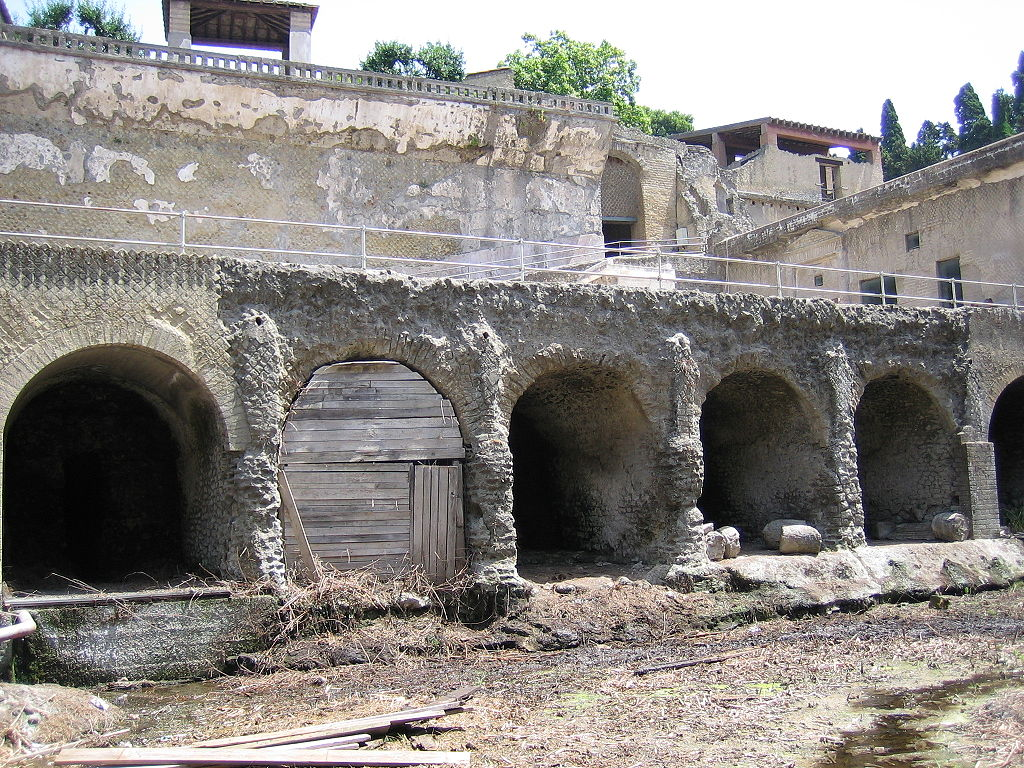
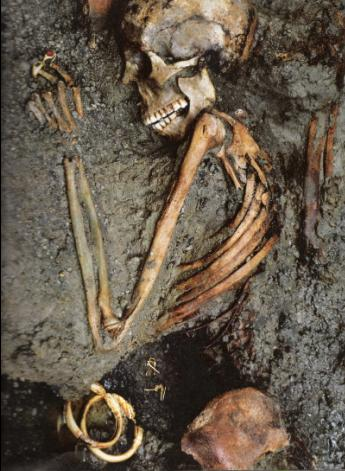
In 1980–82, excavations initially turned up more than 55 skeletons on the ancient beach (just in front the city walls) and in the first six so-called “boat sheds”. Long before this finding, it was believed that the majority of the town’s inhabitants had managed to flee, as only a few skeletons had been unearthed during the excavations. However, this discovery led to a shift in perspective. The last inhabitants waiting for rescue from the sea were probably killed instantly by the intense heat of the pyroclastic flow, despite being sheltered from direct impact. A study of victims’ postures and the effects on their skeletons seemed to indicate that the first surge caused instant death as a result of fulminant shock due to a temperature of about 500 °C (930 °F). Extreme heat caused hands and feet to contract and perhaps fractured bones and teeth.
- S. C. Bisel, “The skeletons of Herculaneum, Italy”, in B. A. Purdy (ed.), Wet Site Archaeology, Caldwell, NJ, 1988, pp. 207–18
- Mastrolorenzo, G.; Petrone, P.P.; Pagano, M.; Incoronato, A.; Baxter, P.J.; Canzanella, A.; Fattore, L. (2001). “Herculaneum Victims of Vesuvius in AD 79”. Nature. 410 (6830): 769–770. Bibcode:2001Natur.410..769M. doi:10.1038/35071167. PMID 11298433. S2CID 205015839.
After a period of finds being mismanaged and deterioration of skeletons, further excavations in the 1990s uncovered a 296 skeletons huddled in 9 of the 12 stone vaults facing the sea and on the beach. While the town was almost completely evacuated, these people found themselves trapped. The “Ring Lady” (see image), named for the rings on her fingers, was discovered there in 1982.
- Wallace-Hadrill, Andrew (2011). Herculaneum: Past and Future. p. 126 ISBN 978-0-7112-3142-9
Eventually, 340 bodies were identified in this area. Analyses of the skeletons suggest it was mainly men who died on the beach, while women and children sheltered and died in the boat houses.
- Martyn, R. et al. (2020). A re-evaluation of manner of death at Roman Herculaneum following the AD 79 eruption of Vesuvius. Antiquity, 94(373), 76-91. doi:10.15184/aqy.2019.215
Recent chemical analyses of the remains provided further insights into the health and nutrition of Herculaneum’s population.[clarification needed]
- High-resolution dietary reconstruction of victims of the 79 CE Vesuvius eruption at Herculaneum by compound-specific isotope analysis: Silvia Soncin et al., University of York, Science Advances 25 Aug 2021: Vol. 7, no. 35, eabg5791, DOI: 10.1126/sciadv.abg5791
Casts of skeletons were also produced to replace the original bones after taphonomic study, scientific documentation and excavation. In contrast to Pompeii, where casts resembling the body features of the victims were produced by filling the body imprints in the ash deposit with plaster, the shape of corpses at Herculaneum could not be preserved due to the rapid vaporisation and replacement of the flesh of the victims by the hot ash (ca. 500 °C). A cast of the skeletons unearthed in chamber 10 is on display at the Museum of Anthropology in Naples.
- Capasso, Luigi (2001). I fuggiaschi di Ercolano. Paleobiologia delle vittime dell’ eruzione vesuviana del 79 d.C. Rome: L’Erma di Bretschneider.
Of exceptional interest is the recent analysis of one of the skeletons (n. 26) discovered in 1982 on the beach next to a boat (on display in the boat pavilion). The remains belong to a military officer (with an elaborate dagger and belt), who was perhaps involved in a rescue mission.
New digs beginning in 2021 will seek to uncover the ancient beach’s western side, where additional skeletons may be discovered.
- “Herculaneum to unearth ancient beach buried for nearly 2,000 years”. 28 January 2021.
Issues of conservation
Main article: Conservation issues of Pompeii and Herculaneum
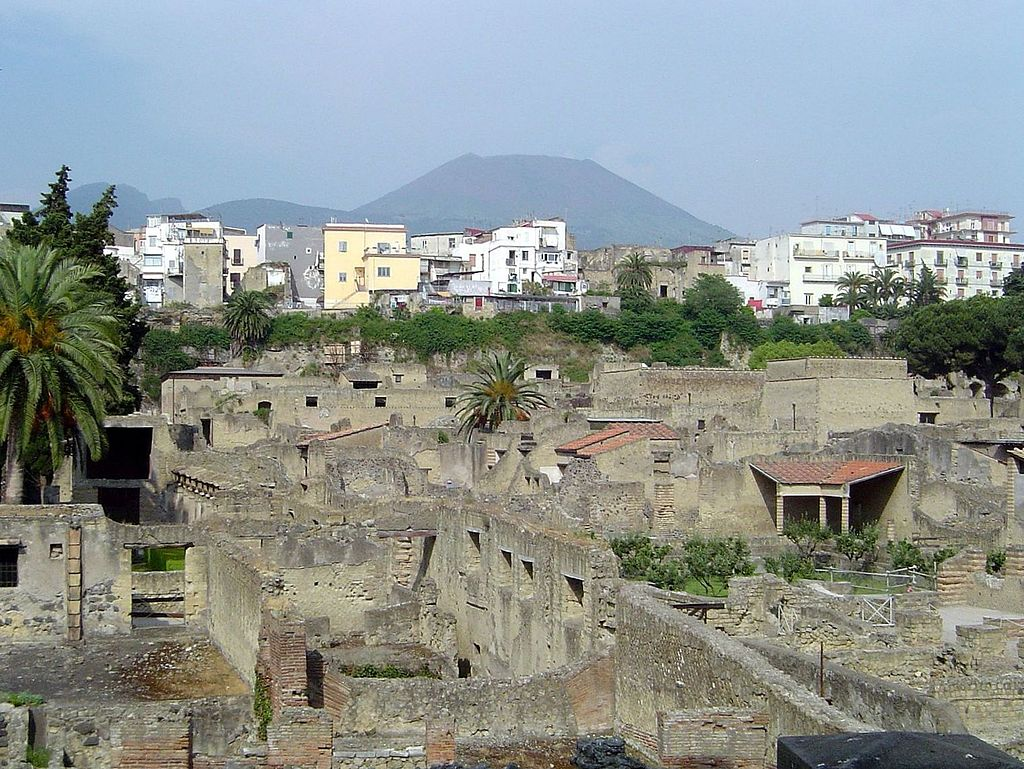
The volcanic ash and debris covering Herculaneum, along with the extreme heat, left it in a remarkable state of preservation for over 1,600 years. However, once excavations began, exposure to the elements began the slow process of deterioration. This was exacerbated by earlier excavation practices, which generally focused on valuable artifacts rather than preserving the archaeological value of the site. Preservation of the skeletal remains became a top priority only in the early 1980s, under the direction of Dr. Sara C. Bisel.
Intensive tourism, vandalism, substandard management, and political ineptitude contributed to the deterioration of numerous sites and buildings. Numerous building foundations have been weakened by water damage caused by modern Ercolano.[citation needed] Reconstruction initiatives have often proved counterproductive. However, recent conservation efforts have had greater success. Today excavations have been temporarily discontinued to direct all funding to conservation programs.
A large number of artifacts from Herculaneum are preserved in the Naples National Archaeological Museum.
Modern conservation
After years of mismanagement, Herculaneum fell into a dire state. However, in 2001, the Packard Humanities Institute began the Herculaneum Conservation Project, a private–public partnership initially set to provide financial aid to local authorities addressing critical issues. The program eventually shifted to include providing skilled expert support and formulating a long-term plan for the site. Since 2001, the Herculaneum Conservation Project has been involved in pilot conservation projects and has partnered with the British School at Rome for training students to maintain the site.
- Wallace-Hadrill, Andrew (2008). The Herculaneum Conservation Project: an introduction. Vesuviana: archeologie a confronto. Bologna.
One of the pilot projects started by the Conservation Project was on the tablinum that had been conserved by Maiuri‘s team in 1938. Over time water had seeped into the wall causing the paint to attach to the previously applied wax and curl away from the wall, stripping it of its colour. However, after working in tandem with the Getty Museum, conservators have created a technique where solvents are used to remove some of the wax and lessen the buildup on the walls so that the paint no longer chips off.
- “Herculaneum Project”. www.getty.edu. Retrieved 27 December 2018.
Photos
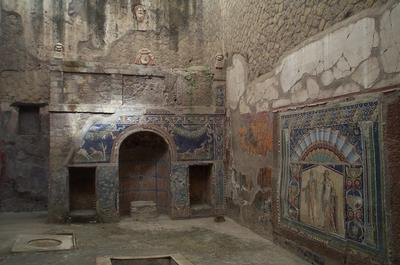
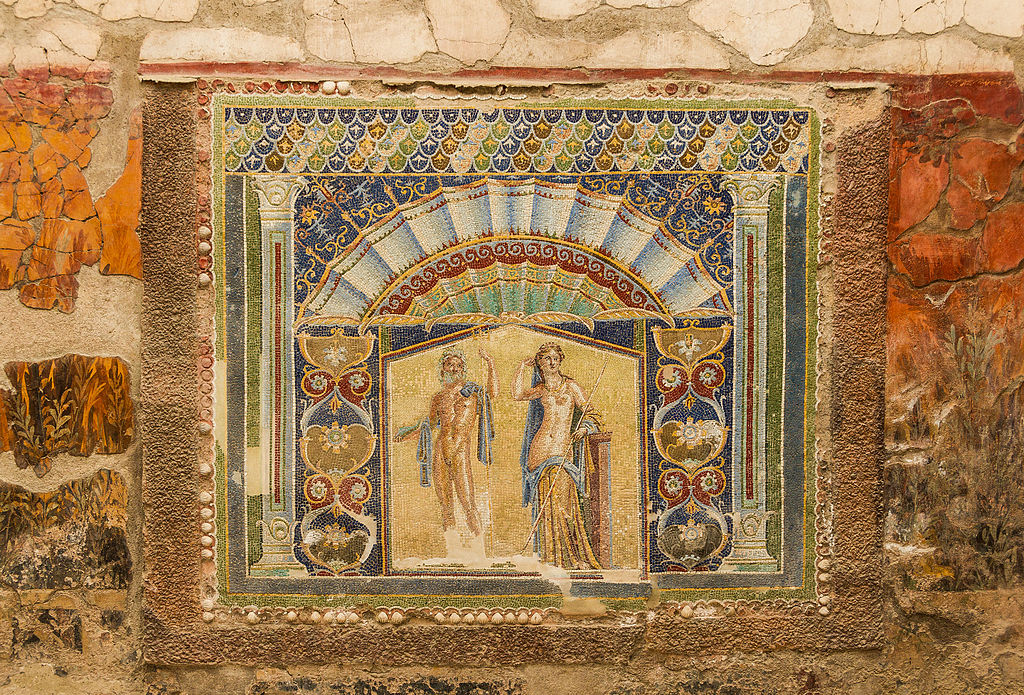
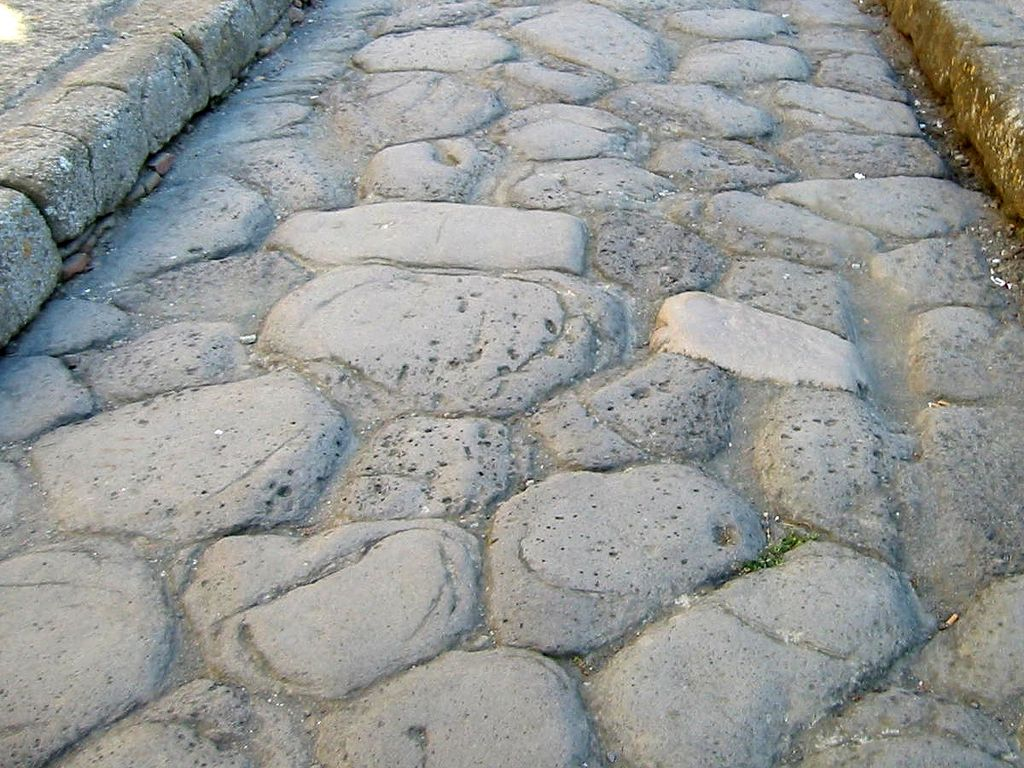
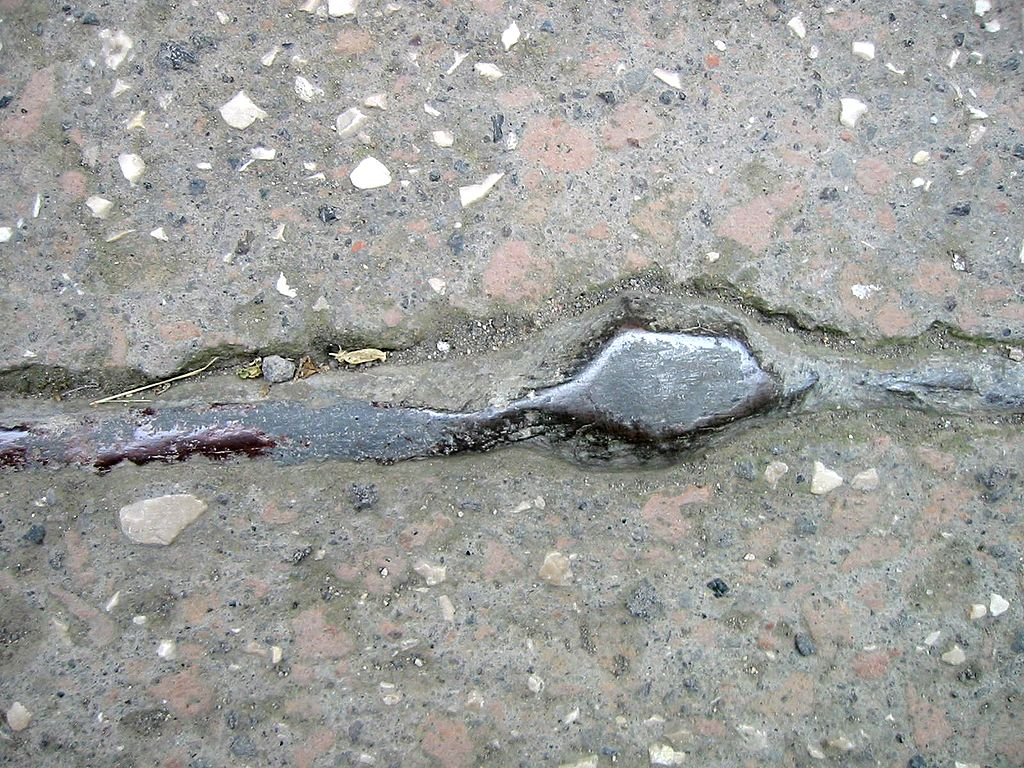
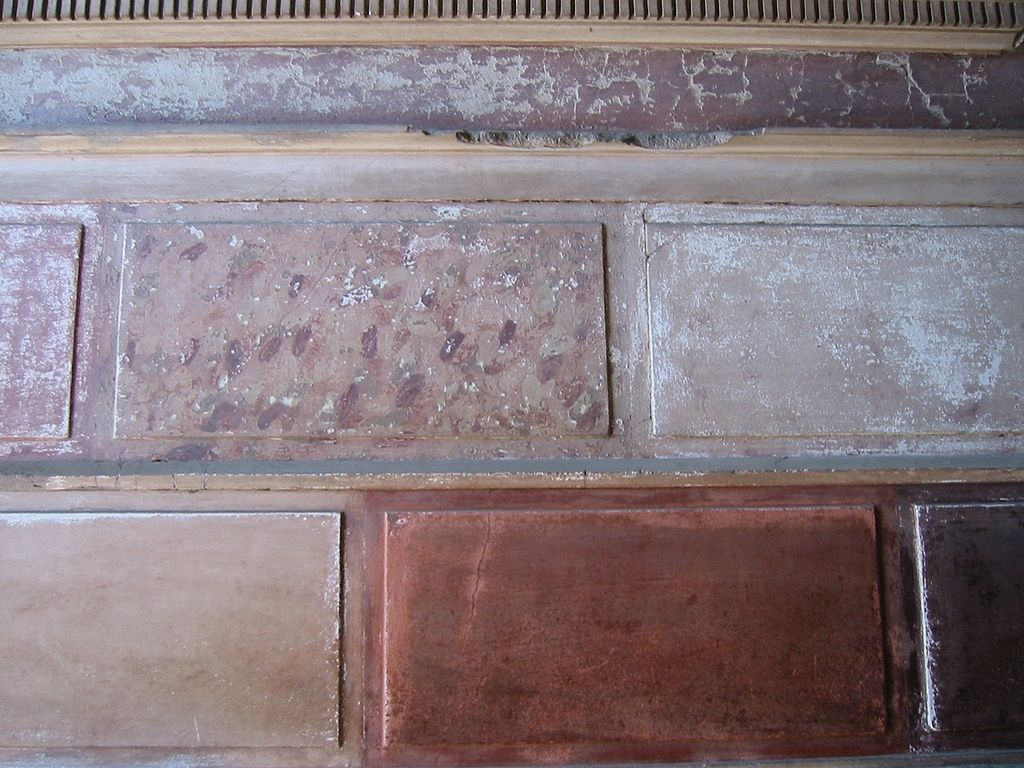
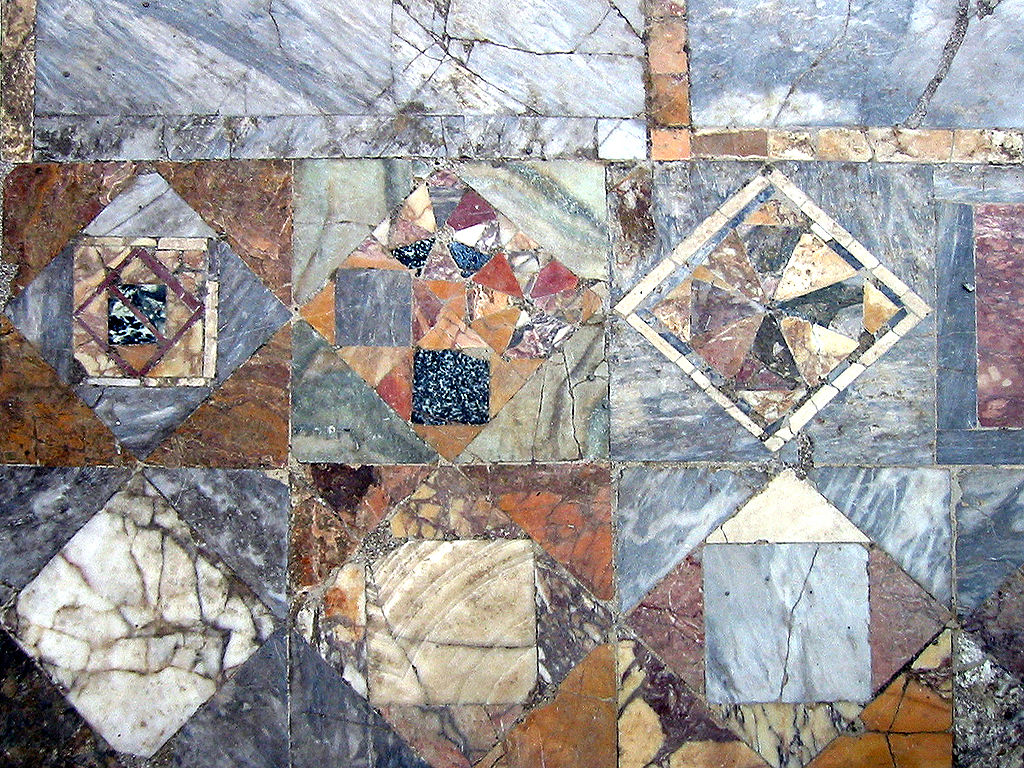
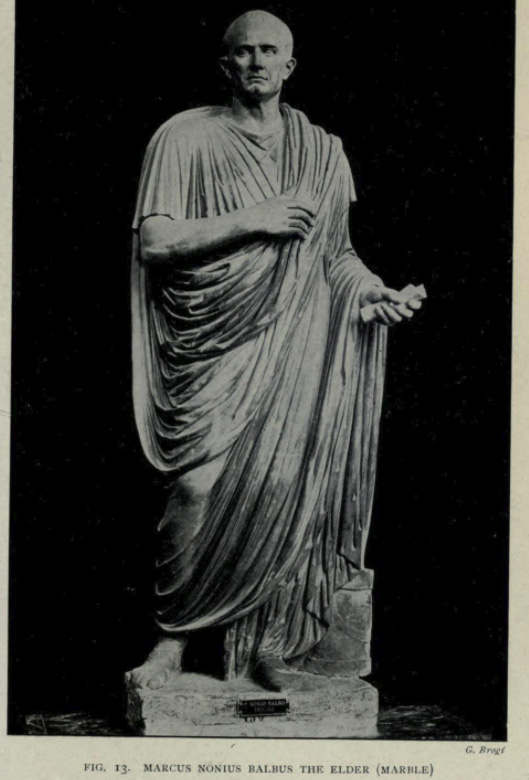
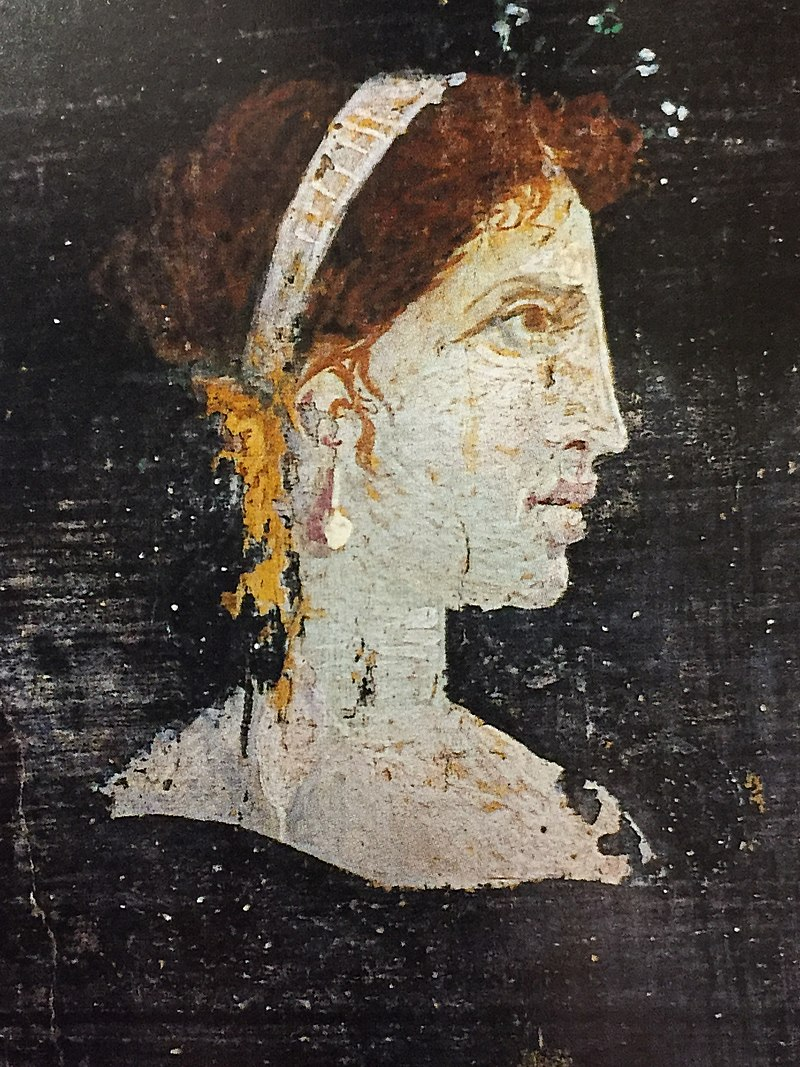
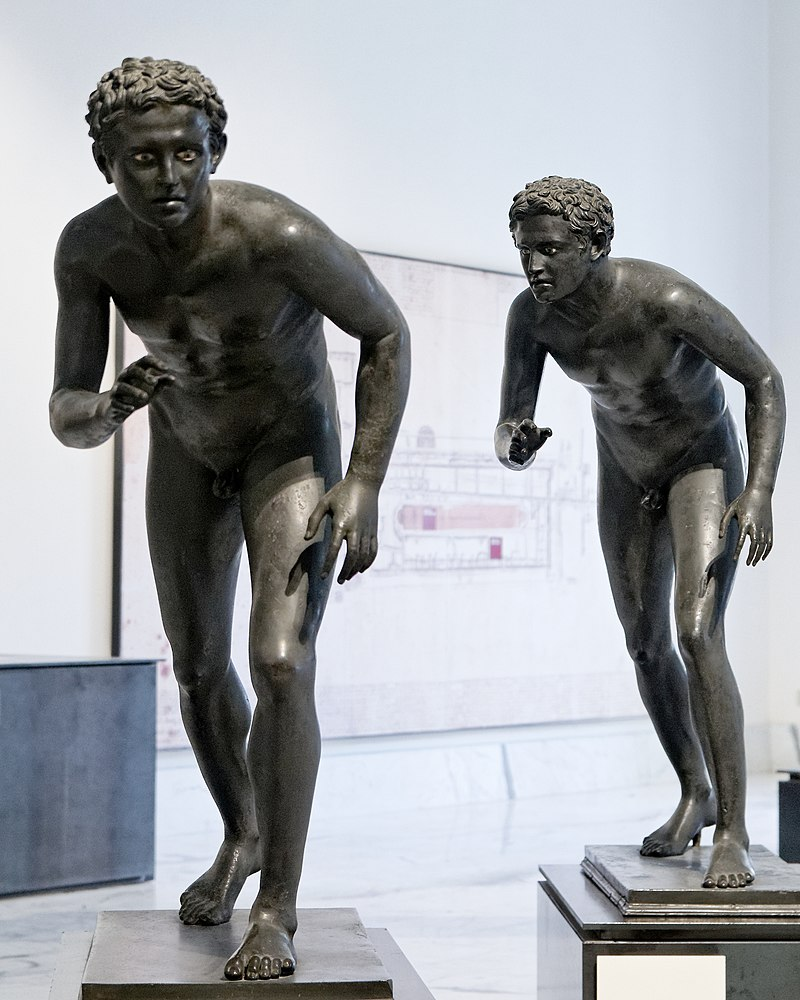
Documentaries
- A 1987 National Geographic special, In the Shadow of Vesuvius, explored the sites of Pompeii and Herculaneum, interviewed archaeologists, and examined the events leading up to the eruption of Vesuvius.
- The 2002 documentary “Herculaneum. An unlucky escape” [41] is based on research of Pier Paolo Petrone, Giuseppe Mastrolorenzo and Mario Pagano. Co-production of DocLab Rome, Discovery Channel USA, France 3 – Taxi Brousse, Spiegel TV, Mediatred, 52′.
- A 2004 documentary “Pompeii and the 79 AD eruption”. TBS Channel Tokyo Broadcasting System, 120′.
- An hour-long drama produced for the BBC entitled Pompeii: The Last Day portrays several characters (with historically attested names but fictional stories) living in Pompeii, Herculaneum and around the Bay of Naples, and their last hours, including a fuller and his wife, two gladiators, and Pliny the Elder. It also portrays the facts of the eruption.
- Pompeii Live, Channel 5, 28 June 2006, 8pm, live archaeological dig at Pompeii and Herculaneum.
- Marcellino de Baggis‘ 2007 documentary “Herculaneum: Diaries of Darkness and Light”, Onionskin productions.[42]
- The 2007 documentary “Troja ist überall: Auferstehung am Vesuv”, Spiegel TV, 43’29.[43]
- “Secrets of the Dead: Herculaneum Uncovered”[44] is a PBS show covering the archaeological discoveries at Herculaneum.
- “Out of the Ashes: Recovering the Lost Library of Herculaneum”[45] is a KBYU-TV documentary that traces the history of the Herculaneum papyri from the time of the eruption to their discovery in 1752 to modern developments that impact their study.
- “The Other Pompeii: Life and Death in Herculaneum”[46] is a documentary presented by Andrew Wallace-Hadrill, director of Herculaneum Conservation Project.
- “Pompeii: The Mystery of the People Frozen in Time”[47] is a 2013 BBC One drama documentary presented by Dr. Margaret Mountford.
- “Pompeii: The New Revelations” was broadcast on UK TV channel 5 in 2021.
- “Unearthed: Vesuvius’ Secret Victim.” Documents the city of Herculaneum and the lives of its people. It revealed that over 1,000 people of Herculaneum’s 5,000 citizens had survived the eruption and were resettled in Naples and Cumae.
Notes
- Ozgenel, Lalo (15 April 2008). “A Tale of Two Cities: In Search of Ancient Pompeii and Herculaneum”. Journal of the Faculty of Archaeology. 2008, Ankara: Middle East Technical University. 25 (1): 1–25. http://jfa.arch.metu.edu.tr/archive/0258-5316/2008/cilt25/sayi_1/1-25.pdf
- Wallace-Hadrill, Andrew (2011). Herculaneum: Past and Future. ISBN 978-0-7112-3142-9. p47
- De Ligt et al. (2012). “The Album of Herculaneum and a model of the town’s demography.” Journal of Roman Archaeology, 25, 69–94. doi:10.1017/S1047759400001148
- Wallace-Hadrill, Andrew (2011). Herculaneum: Past and Future. ISBN 978-0-7112-3142-9. p55
- Antiquitates Romanae 1.44
- Strabo, Geography V, 4, 8
- Wallace-Hadrill, Andrew (2011). Herculaneum: Past and Future. ISBN 978-0-7112-3142-9.
- Available at the University of Arizona: Pliny the Younger, Letters 6.16 and 6.20 to Cornelius Tacitus and in Project Gutenberg: Letter LXV — To Tacitus, Letter LXVI — To Cornelius Tacitus
- Sigurdsson, Haraldur (2001), “Volcanology”, in Meyers, Robert A. (ed.), Encyclopedia of Physical Science and Technology (Third Edition), Elsevier, pp. 579–605
- The Herculaneum Society. Archived 22 February 2012 at the Wayback Machine. p. 3.
- Hooper, John (23 July 2012). “House of the Telephus Relief: raising the roof on Roman real estate”. The Guardian. ISSN 0261-3077. Retrieved 20 March 2023.
- “House of the Relief of Telephus – AD79eruption”. sites.google.com.
- “Pompeii’s destruction date could be wrong”. BBC News. 16 October 2018.
- Stefani, Grete (October 2006). La vera data dell’eruzione. Archeo
- Mastrolorenzo, G; Petrone, P; Pappalardo, L; Guarino, FM (15 June 2010). “Lethal thermal impact at periphery of pyroclastic surges: evidences at Pompeii”. PLOS ONE. 5 (6): e11127. Bibcode:2010PLoSO…511127M. doi:10.1371/journal.pone.0011127. PMC 2886100. PMID 20559555.
- Wallace-Hadrill, Andrew (2011). Herculaneum: Past and Future. ISBN 978-0-7112-3142-9. p 47
- THE LARGE AND THE SMALL HERCULANEUM WOMAN, Universita Ca’ Foscari, Venezia, Doctoral Thesis 2014–2015, Angeliki Ntontou
- The Herculaneum Women: And the Origins of Archaeology (J. Paul Getty Museum) – 7 Feb 2008, Daehner
- Wallace-Hadrill, Andrew (2011). Herculaneum: Past and Future. ISBN 978-0-7112-3142-9. p62
- “Northwest Baths – AD79eruption”. sites.google.com.
- “House of the Dionysian Reliefs – AD79eruption”. sites.google.com.
- Cinque, A. and Irollo, G. (2008) “Lapaleogeografia dell’antica Herculaneum e lefluttuazioni, di origine bradisismica, dellasua linea di costa”. In P. G. Guzzo andM. P. Guidobaldi, eds., Nuove ricerche archeologiche nell’area Vesuviana (scavi 2003–2006): 425–38
- “Charlton T. Lewis, Charles Short, A Latin Dictionary, biclīnĭum”. www.perseus.tufts.edu. Retrieved 20 March 2023.
- “Digital Exploration: Unwrapping the Secrets of Damaged Manuscripts”. www.research.uky.edu. Archived from the original on 1 February 2006. Retrieved 16 December 2016.
- Banerji, Robin (20 December 2013). “Unlocking the scrolls of Herculaneum”. BBC News. Retrieved 27 December 2018.
- “UK scientists stymied in effort to read ancient scrolls”. kentucky. Retrieved 16 December 2016.
- “UK scientists stymied in effort to read ancient scrolls”. kentucky. Retrieved 16 December 2016.
- Hammer, Joshua. “The Fall and Rise and Fall of Pompeii”. Smithsonian. Retrieved 27 December 2018.
- S. C. Bisel, “The skeletons of Herculaneum, Italy”, in B. A. Purdy (ed.), Wet Site Archaeology, Caldwell, NJ, 1988, pp. 207–18
- Mastrolorenzo, G.; Petrone, P.P.; Pagano, M.; Incoronato, A.; Baxter, P.J.; Canzanella, A.; Fattore, L. (2001). “Herculaneum Victims of Vesuvius in AD 79”. Nature. 410 (6830): 769–770. Bibcode:2001Natur.410..769M. doi:10.1038/35071167. PMID 11298433. S2CID 205015839.
- Wallace-Hadrill, Andrew (2011). Herculaneum: Past and Future. p. 126 ISBN 978-0-7112-3142-9
- Martyn, R. et al. (2020). A re-evaluation of manner of death at Roman Herculaneum following the AD 79 eruption of Vesuvius. Antiquity, 94(373), 76-91. doi:10.15184/aqy.2019.215
- High-resolution dietary reconstruction of victims of the 79 CE Vesuvius eruption at Herculaneum by compound-specific isotope analysis: Silvia Soncin et al., University of York, Science Advances 25 Aug 2021: Vol. 7, no. 35, eabg5791, DOI: 10.1126/sciadv.abg5791
- Capasso, Luigi (2001). I fuggiaschi di Ercolano. Paleobiologia delle vittime dell’ eruzione vesuviana del 79 d.C. Rome: L’Erma di Bretschneider.
- “Ercolano riscopre l’ufficiale di Plinio il Vecchio, morì per aiutare – Arte”. 9 May 2021.
- “Herculaneum to unearth ancient beach buried for nearly 2,000 years”. 28 January 2021.
- Wallace-Hadrill, Andrew (2008). The Herculaneum Conservation Project: an introduction. Vesuviana: archeologie a confronto. Bologna.
- “Herculaneum Project”. www.getty.edu. Retrieved 27 December 2018.
- Walker, Susan; Higgs, Peter (2001), “Painting with a portrait of a woman in profile”, in Walker, Susan; Higgs, Peter (eds.), Cleopatra of Egypt: from History to Myth, Princeton, N.J.: Princeton University Press (British Museum Press), pp. 314–315, ISBN 9780691088358.
- Fletcher, Joann (2008). Cleopatra the Great: The Woman Behind the Legend. New York: Harper. ISBN 978-0-06-058558-7, image plates and captions between pp. 246-247.
- “Pagina non trovata • DocLab”. Archived from the original on 1 March 2014. Retrieved 4 October 2010.
- Herculaneum: DVD: Diaries of Light and Darkness. WorldCat. Online Computer Library Center, Inc. OCLC 277147385.
- “Terra X Dokumentationen und Kurzclips”.
- Secrets of the Dead: Herculaneum Uncovered
- “Out of the Ashes: Recovering the Lost Library of Herculaneum”. Archived from the original on 25 April 2012. Retrieved 6 October 2011.
- The Other Pompeii: Life and Death in Herculaneum
- Pompeii: The Mystery of the People Frozen in Time
Further reading
- Brennan, B. 2018.Herculaneum A Roman Town Reborn. Sydney: Ancient History Seminars.
- Brennan, B. 2012. Herculaneum A Sourcebook. Sydney: Ancient History Seminars.
- Capasso, L. 2001. I fuggiaschi di Ercolano. Paleobiologia delle vittime dell’ eruzione vesuviana del 79 d.C. Roma: L’Erma di Bretschneider
- Daehner, J., ed. 2007. The Herculaneum Women: History, Context, Identities. Los Angeles: J. Paul Getty Museum.
- De Carolis, E., and G. Patricelli. 2003. Vesuvius, A.D. 79: The Destruction of Pompeii and Herculaneum. Los Angeles: J. Paul Getty Museum.
- Deiss, J. J. 1995. The Town of Hercules: A Buried Treasure Trove. Malibu, CA: J. Paul Getty Museum.
- Lazer, E. 2009. Resurrecting Pompeii. London: Routledge.
- Pace, S. 2000. Herculaneum and European Culture Between the Eighteenth and Nineteenth Centuries. Naples, Italy: Electa.
- Pagano, M. 2000. Herculaneum: A Reasoned Archaeological Itinerary. Translated by A. Pesce. Naples, Italy: T&M.
- Pagano, M., and A. Balasco. 2000. The Ancient Theatre of Herculaneum. Translated by C. Fordham. Naples, Italy: Electa.
- Pirozzi, M. E. A. 2000. Herculaneum: The Excavations, Local History and Surroundings. Naples, Italy : Electa.
- Scarth, A. 2009. Vesuvius: A Biography. Princeton, NJ: Princeton University Press.
- Wallace-Hadrill, A. 2011. “The Monumental Centre of Herculaneum: In Search of the Identities of the Public Buildings.” Journal of Roman Archaeology 24:121–160.
References
- National Geographic, Vol 162, No. 6. Buried Roman Town Give Up Its Dead, (December, 1982)
- National Geographic, Vol 165, No 5. The Dead Do Tell Tales, (May, 1984)
- Discover, magazine, Vol 5, No. 10. The Bone Lady (October, 1984)
- The Mayo Alumnus, Vol 19, No. 2. An Archaeologist’s Preliminary Report: Time Warp at Herculaneum, (April, 1983)
- Carnegie Mellon Magazine, Vol 4, No. 2. Bone Lady Reconstructs People at Herculaneum, Winter, 1985
- In the Shadow of Vesuvius National Geographic Special, (11 February 1987)
- 30 years of National Geographic Special, (25 January 1995)
- Petrone P.P., Fedele F. (a cura di), 2002. Vesuvio 79 A.D. Vita e morte ad Ercolano, Fridericiana Editrice Universitaria, Napoli.
- Antonio Virgili, Culti misterici ed orientali a Pompei, Gangemi, Roma, 2008.
- National Geographic, Vol 212, No. 3. Vesuvius. Asleep for Now, (September, 2006) http://ngm.nationalgeographic.com/2007/09/vesuvius/vesuvius-text
Resources
- Pliny the Younger‘s letters on the catastrophic eruption of Mt. Vesuvius in 79 A.D. to the Roman historian Tacitus from University of Arizona: Pliny the Younger, Letters 6.16 and 6.20 to Cornelius Tacitus and in Project Gutenberg: Letter LXV – To Tacitus, Letter LXVI – To Cornelius Tacitus
External links
Wikivoyage has a travel guide for Herculaneum.
Wikimedia Commons has media related to Ercolano.
- The local archaeological authorities – Official website Archived 3 October 2017 at the Wayback Machine
- Herculaneum Conservation Project – Official website
- AD 79: Year of Destruction
- 62 Pompeii earthquake
- Herculaneum papyri
- Blogging Pompeii
- The Friends of Herculaneum Society
- The Philodemus Project will publish Philodemus’ works on poetry and on rhetoric.
- Brigham Young University: Herculaneum Scrolls
- Herculaneum Archived 7 June 2011 at the Wayback Machine by Iain Dickson, ‘Melvadius Macrinus Cugerni’
- Herculaneum Uncovered Documentary produced by the PBS Series Secrets of the Dead
- Purcell, N., R. Talbert, T. Elliott, S. Gillies (23 November 2020). “Places: 432873 (Herculaneum)”. Pleiades. Retrieved 8 March 2012.
- Romano-Campanian Wall-Painting (English, Italian, Spanish and French introduction) Archived 7 March 2011 at the Wayback Machine
- “Herculaneum Uncovered – A conversation with Andrew Wallace-Hadrill” Archived 25 March 2014 at the Wayback Machine, Ideas Roadshow, 2013
- Texts on Wikisource:
- “How was Herculaneum Destroyed?” in Popular Science Monthly, Volume 2 (December 1872)
- “Herculaneum“. New International Encyclopedia. 1905.
- “Herculaneum“. The Nuttall Encyclopædia. 1907.
- “Herculaneum“. Encyclopædia Britannica. Vol. 13 (11th ed.). 1911. pp. 342–344.; contains a plan of Villa Ercolanese
| Archaeological sites in Campania |
|---|
| Landmarks of Campania |
|---|
- Herculaneum (ancient city)
- Roman towns and cities in Italy
- Roman sites of Campania
- Destroyed cities
- Natural disaster ghost towns
- Archaeological parks
- Archaeological sites in Campania
- Coastal towns in Campania
- Museums of ancient Rome in Italy
- National museums of Italy
- Former populated places in Italy
- Populated places established in the 1st millennium BC
- 1st-millennium BC establishments in Italy
- Ercolano
- Heracles
- Human remains (archaeological)
- Mount Vesuvius
- 1738 archaeological discoveries
- World Heritage Sites in Italy
- 79 disestablishments
- Populated places disestablished in the 1st century
Leave a Reply